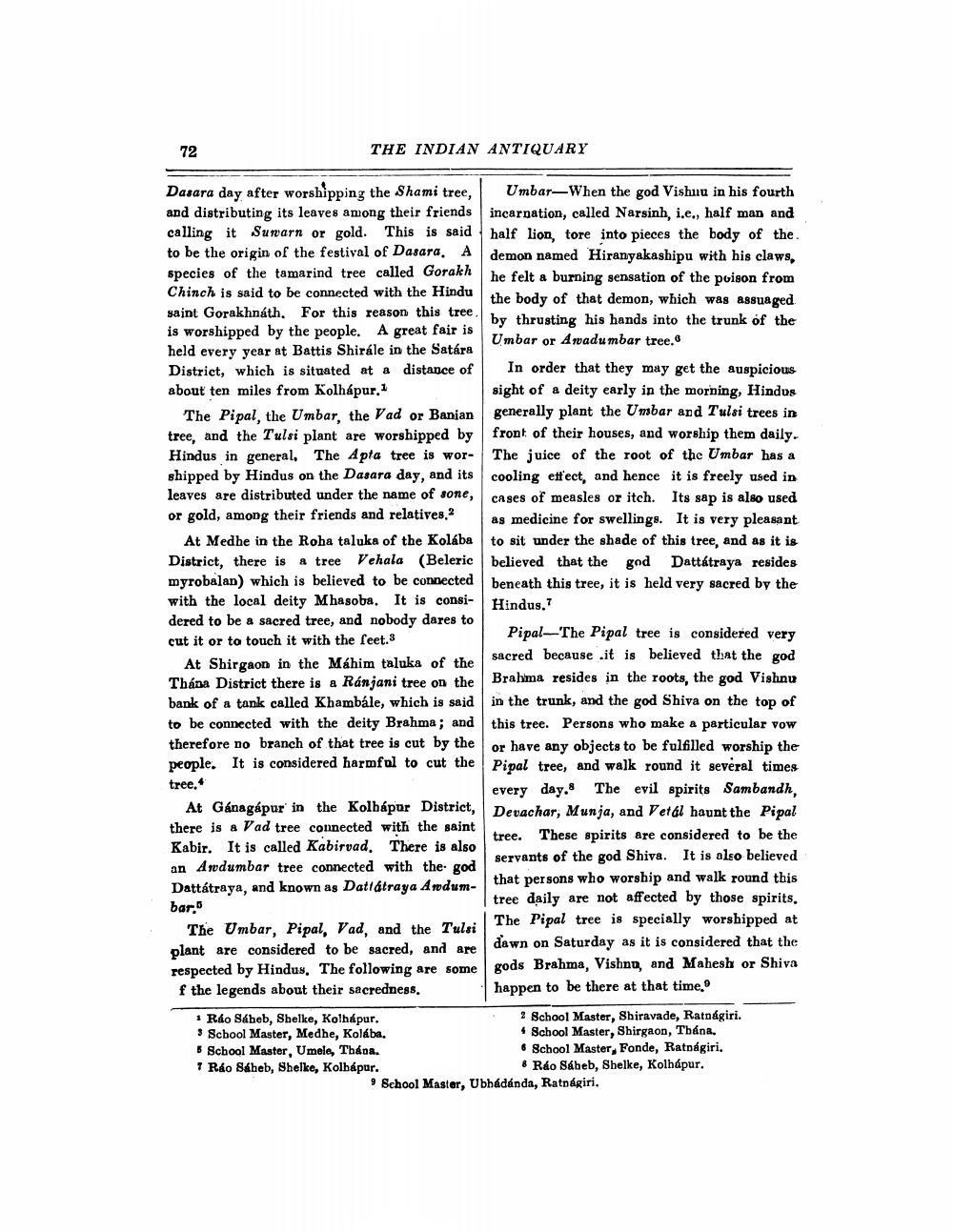________________
72
THE INDIAN ANTIQUARY
Dasara day after worshipping the Shami tree, and distributing its leaves among their friends calling it Suwarn or gold. This is said to be the origin of the festival of Dasara. A species of the tamarind tree called Gorakh Chinch is said to be connected with the Hindu saint Gorakhnáth. For this reason this tree, is worshipped by the people. A great fair is held every year at Battis Shirále in the Satára District, which is situated at a distance of about ten miles from Kolhápur, 1
The Pipal, the Umbar, the Vad or Banian tree, and the Tulsi plant are worshipped by Hindus in general, The Apta tree is worshipped by Hindus on the Dasara day, and its leaves are distributed under the name of sone, or gold, among their friends and relatives,
At Medbe in the Roha taluka of the Kolába District, there is a tree Vehala (Beleric myrobalan) which is believed to be connected with the local deity Mhasoba. It is considered to be a sacred tree, and nobody dares to cut it or to touch it with the feet.
At Shirgaon in the Mahim taluka of the Tháda District there is a Ránjani tree on the bank of a tank called Khambále, which is said to be connected with the deity Brahma; and therefore no branch of that tree is cut by the people. It is considered harmful to cut the tree.
At Gánagápur in the Kolhápur District, there is a Vad tree connected with the saint Kabir. It is called Kabirvad. There is also an Awdumbar tree connected with the god Dattatraya, and known as Dattatraya Awdumbar,
The Umbar, Pipal, Vad, and the Tulsi plant are considered to be sacred, and are respected by Hindus. The following are some f the legends about their sacredness.
Umbar-When the god Vishnu in his fourth incarnation, called Narsinh, i.e., half man and half lion, tore into pieces the body of the demon named Hiranyakashipu with his claws, he felt a burning sensation of the poison from the body of that demon, which was assuaged. by thrusting his hands into the trunk of the Umbar or Awadumbar tree.
In order that they may get the auspicious sight of a deity early in the morning, Hindus generally plant the Umbar and Tulsi trees in front of their houses, and worship them daily. The juice of the root of the Umbar has a cooling effect, and hence it is freely used in cases of measles or itch. Its sap is also used as medicine for swellings. It is very pleasant to sit under the shade of this tree, and as it is believed that the god Dattatraya resides beneath this tree, it is held very sacred by the Hindus.7
Pipal--The Pipal tree is considered very sacred because it is believed that the god Brahma resides in the roots, the god Vishnu in the trunk, and the god Shiva on the top of this tree. Persons who make a particular vow or have any objects to be fulfilled worship the Pipal tree, and walk round it several times every day. The evil spirits Sambandh, Devachar, Munja, and Vetál haunt the Pipal tree. These spirits are considered to be the servants of the god Shiva. It is also believed that persons who worship and walk round this tree daily are not affected by those spirits. The Pipal tree is specially worshipped at dawn on Saturday as it is considered that the vods Brahma, Vishng, and Mahesh or Shiva happen to be there at that time,
* Báo Sáheb, Shelke, Kolhấpur,
2 School Master, Shiravade, Ratnagiri. 3 School Master, Medhe, Kolába,
School Master, Shirgaon, Thána. 3 School Master, Umele, Thána.
& School Master, Fonde, Ratnagiri. 7 Báo Báheb, Shelle, Kolkapur.
8 Ráo Saheb, Shelle, Kolkapur. 9 School Master, Ubhádánda, Ratnagiri,




